 |
 |
 |
| |
Frailty Phenotype in Canadian Men and Women with HIV. from Jules: Fried Frailty test is too simple in HIV
|
| |
| |
Reported by Jules Levin
9th Intl HIV and Aging Workshop 2018 Sept 13-14 NYC
Mehmet Inceer*, Marie-Josée Brouillette, Lesley K. Fellows, Nancy E. Mayo for the Positive Brain Health Now investigators (Marianne Harris, Fiona Smail, Graham Smith, Réjean Thomas)
....from Jules: the point I take away is that older Fried Frailty test does not work in HIV, there are many additional factors that were identified in this study using other tests of mental & physical functioning and they found 40% cognitively impaired, 72% low activity, 90% slow, and the Aging Wk report I just sent immediately prior in email highlights in further detail poor physical & mental functioning of older aging HIV+.
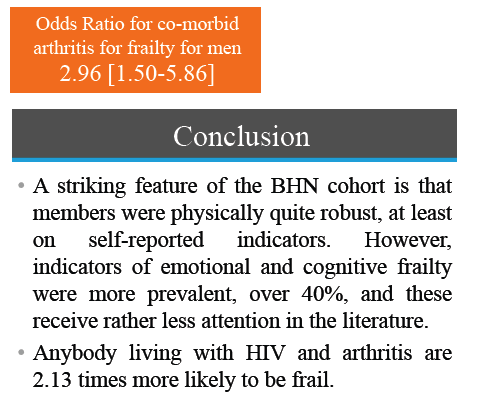
Reported by Jules Levin
9th Intl HIV and Aging Workshop 2018 Sept 13-14 NYC
Mehmet Inceer*, Marie-Josée Brouillette, Lesley K. Fellows, Nancy E. Mayo for the Positive Brain Health Now investigators (Marianne Harris, Fiona Smail, Graham Smith, Réjean Thomas)
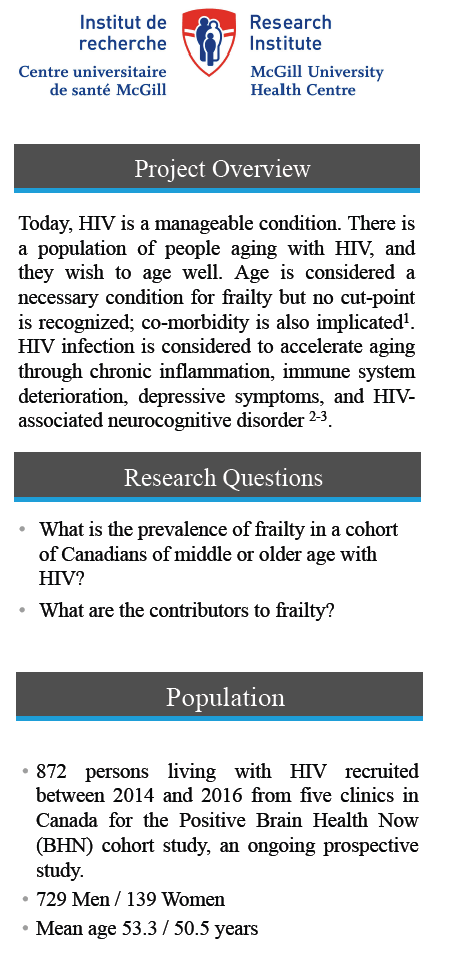
program abstract
Frailty Phenotype in Canadian Men and Women with HIV
Inceer M1, Brouillette M1, Fellows L1, Mayo N1
1Mcgill University, Montreal, Canada
Background: Treatment success for HIV infection over the past two decades has resulted in a shift from a disease with a dire prognosis to a manageable condition. There is now a population of people aging with HIV, and they wish to age well. One impediment to active aging is the emergence of frailty1, 2. Frailty has been defined as "a multidimensional syndrome characterized by decreased reserve and diminished resistance to stressors", however, there is no agreed upon way of operationalizing frailty3. Age is considered a necessary condition for frailty but no cut-point is recognized; co-morbidity is also implicated3. HIV infection is considered to accelerate aging through chronic inflammation, immune system deterioration, depressive symptoms, and HIV-associated neurocognitive disorder4-6. Evidence for the importance of frailty in HIV is provided by the observation that there are over 719 reviews of this topic, 367 in the past 5 years.
Objective: The purpose of this study is to estimate the prevalence of frailty in a cohort of Canadians of middle or older age with HIV and identify contributors to prevalence. The data for this analysis came from the Positive Brain Health Now (BHN) cohort, an ongoing prospective study involving 872 persons living with HIV recruited between 2014 and 2016 from five clinics in Canada.
Methods: Fried's criteria (≥3 of 5) for frailty was operationalized using items from the SF-36 indicating slow gait speed, weak grip strength, and exhaustion, and low Body Mass Index (<21), and low physical activity.
Results: Out of the 729 men (mean age 53.3 years) and 139 women (mean age 50.5 years) with useable data, 55 (7.5%) of men and 17 women (12.2%) met Fried's criterion for frailty, ≥3 of 5 criteria. Using a more global criterion, <45/100 on the Physical Function Index (PFI) of the SF-36, the prevalence of frailty was 9.3% among men and 15.8% among women. The average values on the PFI for members of this cohort were 82/100 for men and 77/100 for women, slightly lower than age-expected norms (89 and 87, for men and women, respectively). However, on other domains covered by the sub-scales of the SF-36, members of this cohort scored ≈1/3 less than members of their peer group. In contrast to the low prevalence of frailty, over 40% met the cut-point for major depression (≤60/100) on the Mental Health Index (MHI). Results on neuropsychological testing indicated that 46% met criteria for severe cognitive impairment. The strongest contributor to frailty in this population was co-morbid arthritis.
Discussion: The estimate of frailty in the BHN cohort was lower than estimates from similar HIV populations. However, these estimates are similar to general population estimates but for people at least 10 years older. A striking feature of the BHN cohort is that members were physically quite robust, at least on self-reported indicators. However, indicators of emotional and cognitive frailty were more prevalent, over 40%, and these receive rather less attention in the literature.
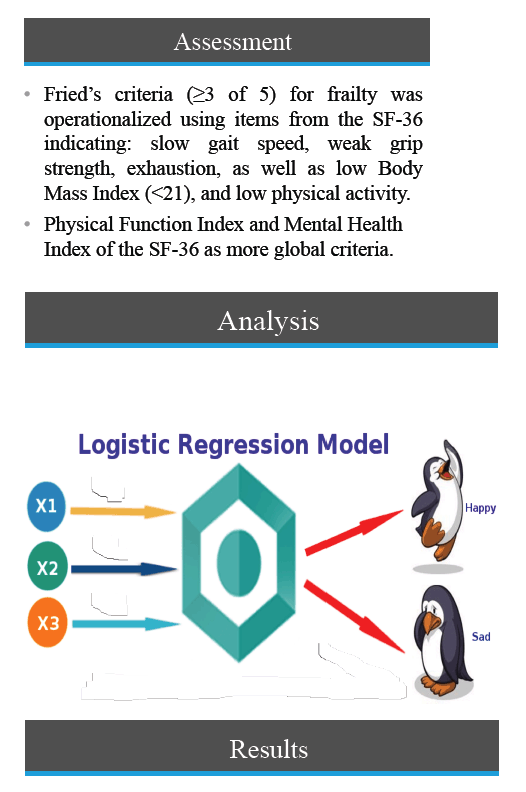
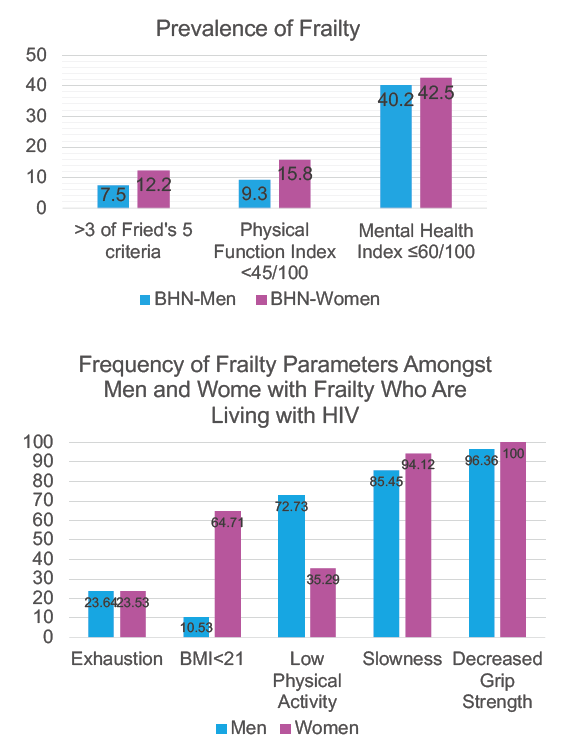
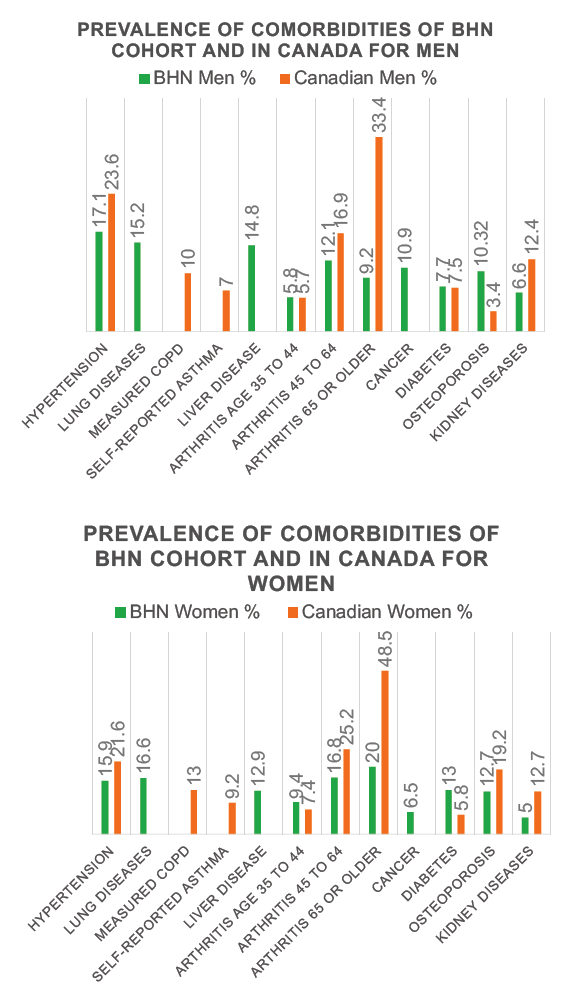
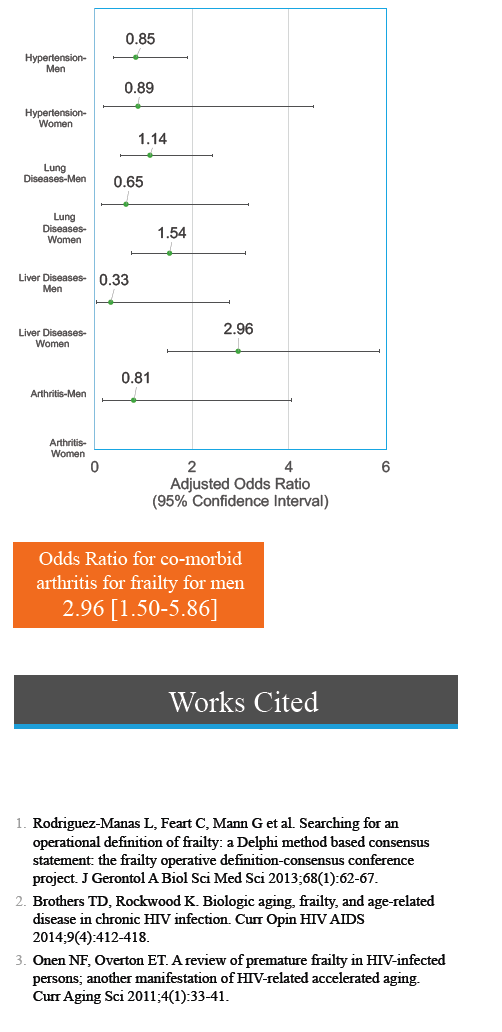

|
| |
|
 |
 |
|
|